Indus Valley Civilization Notes for UPSC Exams
Indus Valley Civilization
Indus Valley Civilization, also known as Harappan civilization was the first urban culture in the Indian subcontinent. It was a bronze age culture that flourished in North-western Indian subcontinent. It was earlier known as the Indus valley civilization as most sites discovered were near the Indus valley river system.
However, as the discovery of newer sites outside the Indus river system progressed it became clear that the extent of the civilization covered even the Ganga plains. Scholars now prefer to call it Harappa Civilization, after name of the first site discovered here.
Chronology of Indus Valley Civilization
Although various sites in the Indus valley dates back to the Neolithic era from before 5000BCE, the ‘bronze age’ Harappan civilization is dated between 3300 BCE to 1300 BCE. This whole period is divided into three phases: Early Harappan, Mature Harappan and Late Harappan, as given below –
| Harappan Phases | Important Sites | Features | |
| Early Harappan (3300-2600BCE) | 1A/B Ravi Phase (Hakraware) (3300 – 2800BCE) | Harappa, Amri Nal | Regionalisation Phase Small settlements Development of trade network, Increasing Specialisation in Crafts |
| 2 – Kot Diji Phase (2800-2600BCE) | Kot Diji | ||
| Mature Harappan (2600- 1900BCE) | Further divided into three phases: 3A (2600-2450BCE) 3B (2450-2200BCE) 3C (2200-1900BCE) | Mohenjo-Daro, Harappa, Kalibangan, Dholavira. | Integration Phase Organised irrigation system Full-scale urbanisation, Emergence of writing Uniformity in artefacts, Full-fledged trade |
| Late Harappan (1900- 1300BCE) | 4 -Transitional Phase (1900-1700BCE) | Late Siswal, Rojdi, Rangpur | Localisation phase Decline, Abandonment of some sites, Rise of the pastoral mode |
| 5 – Cemetary H Phase (1700-1300BCE) | Cemetery-H at Harappa, Ochre colour pottery (OCP) | ||
Early Harappan cultures
These are situated in four clusters of cultures which cover the entire Indus basin and parts of Baluchistan. They are: –
1. Kot Dijian culture
- It is the largest area covering NWFP, Pakistan’s Punjab and northern Sindh.
- It was occupied during both the early Harappan and mature Harappan phases.
2. Sothi-Siswal culture
- It covers northern Rajasthan (Kalibangan), Indian Punjab and Haryana.
- It was fortified with a wall.
- Mud brick houses with central courtyards were found here.
- A large hoard of lapis lazuli micro-beads was found here.

3. Amri-Nal
Amri-Nal is spread in Baluchistan, Central and Southern Sindh, with extensions in Gujarat.
- Some of the settlements were fortified.
- In Baluchistan, Nal pottery and Sindh, Amri pottery were found.
- The people here were pastoralists, migrating to the highlands in summer and Indus valley in winter.
4. Damb Sadaat
- It is a part of Central Baluchistan.
- Pottery similar to Kot Diji was found here but it had a distinct plant, animal and geometric motifs.

5. Mature Harappan Culture
During this phase, Harappan culture reached its peak and was the largest civilisation in the ancient world. It covered large parts of Pakistan and North-West India, and one site is located in Afghanistan.
- We have found some new types of potteries (style, clay fabrics, vessel forms and painting) apart from the continuous previous phase.
- There was an increasing use of bronze.
- Use of Baked bricks in buildings and writing was now a standard across all sites.
- Civic amenities such as houses with bathrooms, an efficient network of roads, and an elaborate system of drainage and water supply system were now a common feature across all sites.
6. Late Harappan Culture
By 1900BCE most of the mature Harappan cities were abandoned. People settled into new sites in Gujarat, Haryana and western UP, although, a few older Harappan sites continued to be occupied such as Siswal(Called late Siswal in late Harappan), Rangpur, Swat and Jhukar.

- There was a disappearance of distinctive features of Harappan culture such as weights, seals, special beads, writing, long-distance trade, large public structures and craft specialisation
- House construction techniques deteriorated.
- There seems to be the arrival of a new group of people with distinct burial practices. They have different pottery than Harappans. Their cultures came to be known as ‘Cemetery H‘ culture (Late Siswal Culture).
The Extent of the Indus Valley Civilization
The Indus valley civilization extended from Manda in Kashmir to South Diamabad in the south and from Suktagendor in the west to Alamgirpur in the East.

There are hundreds of sites in the Harappan civilization. Most of them have similar finds such as seals, beads, pottery and city structure. However, there are few major sites which are rich in artefacts.
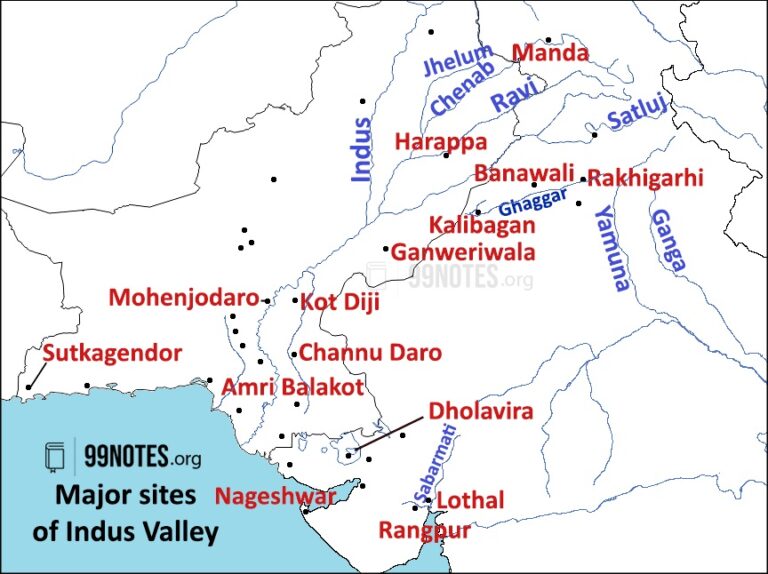
Following are the eight most important Indus valley civilization sites.
Mohenjo-Daro (the mound of the dead)  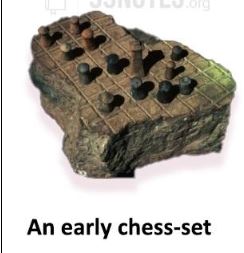 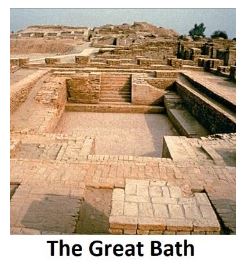 Imagesource: https://www.harappa.com/slide/great-bath-mohenjo-daro-0 Imagesource: https://www.harappa.com/slide/great-bath-mohenjo-daro-0 |
Major buildings/Artefacts discovered here:
The Great Bath- It is the unique feature in this site. It was situated in the citadel part of the town in a hall.
|
Harappa 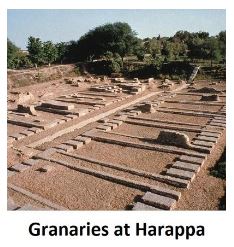 https://www.harappa.com/slide/granary-harappa https://www.harappa.com/slide/granary-harappa |
Major buildings/Artefacts discovered here:
|
Kalibangan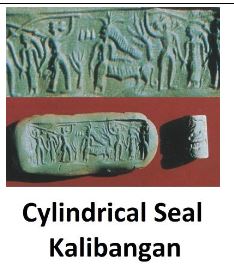 https://www.harappa.com/blog/indus-cylinder-seals https://www.harappa.com/blog/indus-cylinder-seals |
|
Chanhudaro 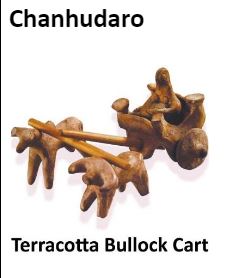 |
|
Lothal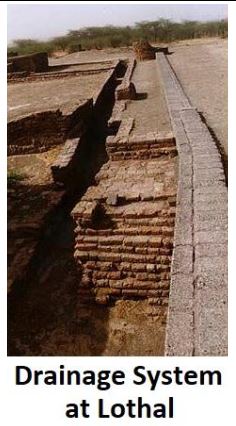 https://www.harappa.com/lothal/14.html https://www.harappa.com/lothal/14.html |
|
Dholavira 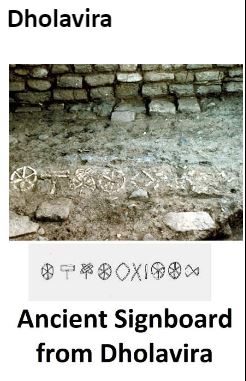 |
|
Banawali 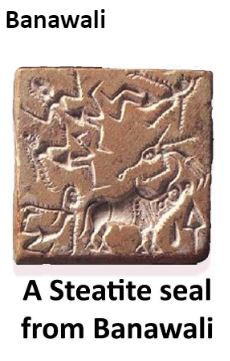 |
|
Rakhigarhi (Hisar,Haryana)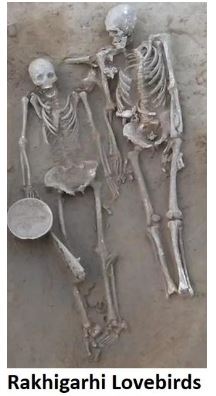 Source:https://www.bbc.com/news/world-asia-india-46806084 Source:https://www.bbc.com/news/world-asia-india-46806084 |
|
The Indus valley Civilization saw many striking features that the civilizations of that time, namely, Mesopotamia, Egypt and China lacked. These include the focus on sanitation, city planning, secular society and the degree of equality. This aspect is discussed in detail in our next page.
Chronology of Excavations/Discovery of sites
Following is the gist of all the major excavations that have taken place till date in the Indus valley civilization.
| Year | Archaeologist | Excavations/Finds |
| 1829 | Charles Masson | He came across Harappa in 1829 and wrongly identified it as Sangala, a city of the time of Alexander. |
| 1856 | Alexander Cunningham (1st ASI director) | Visited Harappa & wrongly concluded it to be a Buddhist monastery. |
| 1872-75 | He published about 1st Harappan Seal and said it was not of Indian origin as it depicted a bull without a hump. | |
| 1900s | Daya Ram Sahni (1st Indian ASI director) | Discovered many Seals in the area. |
| 1921 | Began excavating Harappa with MS Vats, on the banks of the river Ravi. | |
| 1921 | Rakhal Das Banerji, Ernest JH Mackay, John Marshall (ASI director) |
Found similar seals at Mohenjo-Daro, leading to the conjecture that sites were part of a single archaeological culture. Continued excavation by JH Mackay, GF Dales & MS Vats. |
| 1946 | REM Wheeler | Excavates Harappa and Kot Dijian deposits |
| 1955 | SR Rao | Began excavations at Lothal. |
| 1955 | F.A Khan | Identified Kot Diji |
| 1960 | BB Lal & BK Thapar | Began excavations at Kalibagan |
| 1974 | MR Mughal | Began excavations at Bahawalpur |
| 1980 | German & Italian team | Began surface explorations at Mohenjo-Daro. |
| 1986 | American team | Began excavations at Harappa. |
| 1990 | RS Bisht | Began excavations at Dholavira. |
| 2004 | L.S Rao | Began excavations at Bhirrana (Haryana) |
| 2019 | New archaeological findings in Keezhadi (Tamil Nadu) suggested connection with Harappan culture | |
| 2022 | S K Manjul | New round of excavations at Rakhigarhi |






![Mauryan Empire (321-185 Bce): Rulers, Map, &Amp; Administration [Complete Notes For Upsc Exams] | Updated November 16, 2025 Mauryan Empire (321-185 Bce): Rulers, Map, &Amp; Administration [Complete Notes For Upsc Exams]](https://www.99notes.in/wp-content/uploads/2023/04/mauryan-empire-99notes-upsc-1-768x495.webp)
